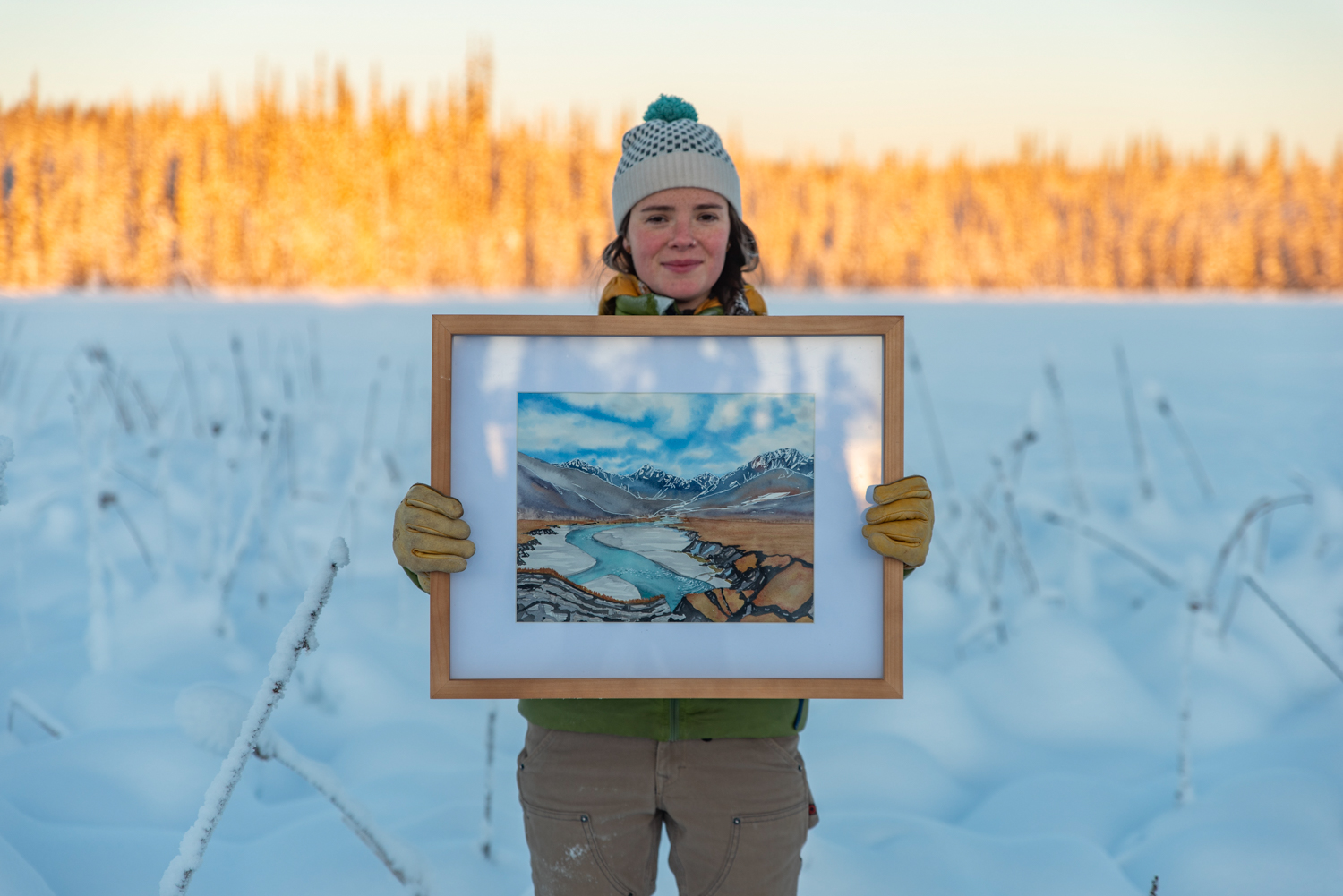Alaska Artist Jill Richie on Creativity that Contributes to Collective Action

Jill Richie is a Fairbanks, Alaska-based plein air painter and archaeologist who uses watercolors as a tool for observation, recreation, and education. She sent in a submission last spring before we hit a big pause button in order to redesign our website, but it feels fitting to be sharing her winter landscape paintings and close-up ice studies now, when there’s a nip in the air and winter’s first snow is still accumulating outside my window.

In recent years, art has been a humbling way for Jill to redefine her relationship with natural and cultural environments, and she’s continuing to learn how it can be a catalyst for reciprocity.
Part of this redefinition was that new parenthood called Jill to seek out a creative outlet that she could take with her (and her baby) outdoors. But more broadly, art and Jill’s creative exploration of human connection with environments—both past and present—also shapes her lifestyle as an outdoor enthusiast, advocate, and her career as an archaeologist.
She says, “My art is grounded in place-based watercolors and I thrive on painting en plein air. Whether I’m in the backyard or the backcountry, I take note of my surroundings in sketchbooks. This creative process is a form of being in conversation with the environment and can be a tool to protect it.”
Let’s get to know Jill better through her work, and in more of her own words.
Jill Richie on painting as her creative outlet in new parenthood, continual learning, and collective action.
I grew up in Alaska and currently live in Fairbanks, the traditional lands of the Dene people of the lower Tanana River, with my husband Mat, a wildlife biologist, and our two young daughters, one human, one husky. I consider myself to be a community-taught artist supported by imaginative family and friends, encouraged by makers near and far, and buoyed by techniques that evolve (or don’t!) each time I create. Growing up in Alaska, nature was an ever-present companion.
Plein air painting became my creative outlet when I entered parenthood in 2019. Eager to maintain outdoor hobbies and friendships, with a body in recovery and a baby in tow, my watercolor kit became as essential as the diaper bag when I’d head out the door.
Painting, it turned out, was a great thing for me to do while nursing a newborn in the foothills or taking a break on the skin track. I didn’t always make it to the top of every mountain, but these sketches, pauses, and observations laid the foundation for a stable creative practice and a new relationship with nature.

Jill painting while her bundled baby naps next to her.
I believe art encourages an intimate relationship with your subject, whatever it may be. Artists are constantly posed with decisions—how to capture this color, interpret this shape, translate this emotion—but by embedding my artistic practice in the environment, I’m also contending with shifting light, inclement weather, ravenous mosquitoes, and a little 8-month season we call winter.
The more I painted the land on the land, the more curious I grew about details behind the aesthetics. Geomorphology and weather patterns, botany and cultural history occupied my thoughts. When I pause in the landscape instead of only moving through it, I realize how much I have to learn.

Katsi Tlaadi
I’d return home from an outing with tired legs, a sketch or two, and more questions than I’d started with. Building well-rounded knowledge of the places I paint has become one small part of my responsibility—and joy—of being an artist and a steward. These environments are filled with story, knowledge, memory, and opportunity.
While the purpose of many of my sketches are sentimental and experimental, they also have the power to be an act of reciprocity. Art is a form of being in conversation with the environment and can be a tool to protect it.
I’m committed to deepening themes of education and advocacy in my work by seeking opportunities for art to support social and environmental justice initiatives. In the last year, my art has connected me with creatives and Indigenous leaders working to protect the Arctic National Wildlife Refuge from oil and gas development. It has raised funds to support local non-profit organizations. It has encouraged voting and civic engagement. It has coalesced into personal projects like “Alaska Place Names Illustrated” that strengthen my relationship to the land, educate fellow visitors, and honor Indigenous people who have stewarded it for millennia—and continue to do so. I share these examples to remind you—and myself—of the myriad ways that art can contribute to broader causes and collective action.


Kobuk
In the long term, my goal for my little pictures is to make an impact on the big picture. Tucked carefully into my backpack, each individual painting is humble and seems unlikely to change anything in my household, let alone the world.
But by dusting them off, committing to learning on and off the page, and sharing them with my community—might they inspire a budding artist to create?
Might they help a new parent develop a new passion that fits into their new lifestyle?
Might they be a record of the environment at this point in time?
Might they raise awareness about an issue?
Might they incentivize a commitment to a cause?
Might they be a way to engage in a reciprocal relationship with the land?
Thanks to generations of artists who have shared this path before, I can wholeheartedly answer, “Yes.”


Learn more about Jill Richie at JillRichieArt.com and see more of her art on Instagram at @jill.richie.art.
- About the Author
- Latest Posts

Hailey Hirst is She Explores‘ digital content editor and brand designer. Her leash-trained tuxedo cat and young daughter join her on the trails close to home in British Columbia and Idaho.


Be the first to comment